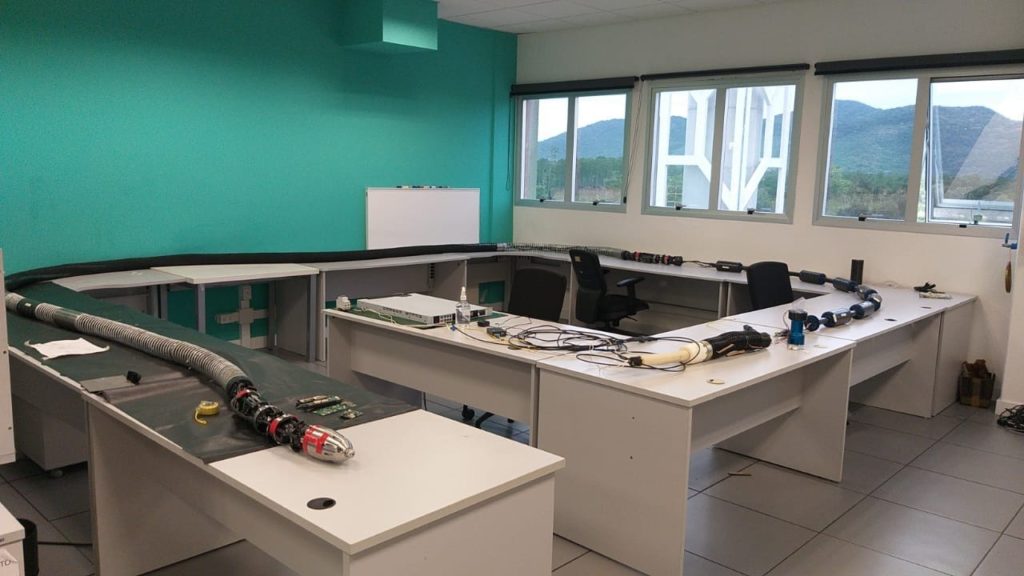São Paulo – A problem that used to be addressed only from the outside in and could cost billions of dollars for the oil industry is on its way to a solution from the inside out. The Annelida robot (pictured above) can move around the tiny spaces of offshore production ducts. The equipment is tasked with cleaning the debris that get stuck in the walls and plug the ducts, preventing the oil from circulating.
Named after the Annelida phylum, also known as the segmented worms, with species including earthworms, the robot aims at saving the money that oil companies such as Brazil’s state-run firm Petrobras would spend on replacing damaged pieces and reducing the time when the equipment would remain unused. The idea came from the demand of the industry. “Petrobras has always had trouble with clogged lines, both in oil production and distribution. They already have a procedure for avoiding clogging, and for quite some time they have this problem of how to recover clogged lines,” said Anselmo Luís da Silva Jr, researcher of the SENAI Institute of Innovation in Embedded Systems in Santa Catarina.
Annelida is focused on removing hydrates and paraffin plugs that cling to the walls of the lines due to the oil solidification during extraction. The oil extracted offshore comes out of the soil at a temperature of 140 to 158 degrees F but gets colder and colder as it runs through 15 kilometers of ocean and can reach 39 degrees F, a change that solidifies the oil, which can clog the ducts.
To arrive at the solution, the teams had to develop 14 new technologies. They included heating, feeding, sensing, control and communication, load transmission, and pressure vessel systems, and even a specific risk analysis process. The resulting robot is able to move around and look like an annelid.
Bio-inspired
While the name of the robot came only after it was ready, the movement solution and its shape have much in common with something that already existed in nature. “In the literature, the principle of movement is called peristalsis. It is [biologically inspired], after all the movement is seen in snakes, for example. But the name itself was not. It was only after we had a concept that someone noticed the resemblance to the annelids,” Silva explained.
The semiautonomous robot can move on its own due to its peristaltic system. “It has its own locomotion and traction system. The robot stands out because of it. It sticks itself on the line walls and moves along it and then come back. This makes it able to take tools for inside operations,” the researcher detailed.
The robot has a very similar shape to the annelids and is long compared to its diameter. In the case of Annelida, it’s 15 meters long and 4 inches across. The body of the robot has to be flexible, just like the annelids, so that it can move freely through the ducts.
Teams from different institutions got together to develop the equipment, including SENAI Institutes of Innovation in Embedded Systems in Florianópolis, Santa Catarina, and Polymer Engineering in São Leopoldo, Rio Grande do Sul, as well the Federal University of Rio Grande do Sul, and the University of São Paulo.
The project was divided into two phases. The first phase, which started back in 2016 and was completed last January, dealt with the operating concept and assembly of the robot as well as ancillary equipment to put it in the field. In this phase, scientists ran tests in controlled environments. The second phase of the project started earlier this year and is expected to span for over 36 months. Now the researchers will develop other five units of the robot for field testing. In this last phase, the teams of the aforementioned institution are also supported by SENAI Manufacturing Systems Innovation Institute as well as startup UpSensor.
In addition to autonomic functions, the robot has some remotely controlled functions. The final phases include transferring these technologies to the industry. With the solutions built, Annelida could even be used in onshore oil extraction plants.
Translated by Guilherme Miranda




